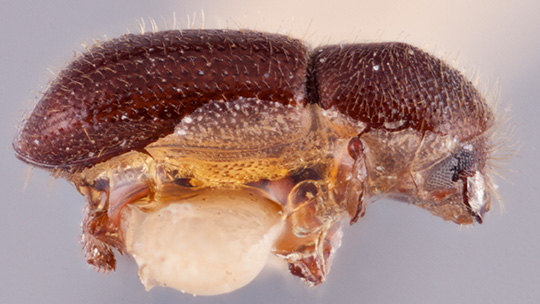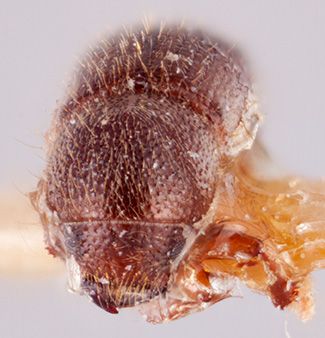Ambrosiophilus satoi
|
Ambrosiophilus satoi paratype lateral; R.K. Osborn |
|
Ambrosiophilus satoi paratype dorsal; R.K. Osborn |
|
Ambrosiophilus satoi paratype declivity; R.K. Osborn |
|
Ambrosiophilus satoi paratype frontal; R.K. Osborn |
Taxonomic history
Xyleborus satoi Schedl, 1966b: 39.
Ambrosiophilus satoi (Schedl): Beaver and Liu, 2010: 22
Diagnosis
2.5−2.75 mm long (mean = 2.67 mm; n = 5); 2.5−2.57 times as long as wide. This species is distinguished by all declivitaldeclivital:
pertaining to the elytral declivity
interstriae granulategranulate:
pertaining to a coarse, grainy surface texture
 on upper half of declivitydeclivity:
on upper half of declivitydeclivity:
downward slope of either the pronotum or elytra
 ; pronotumpronotum:
; pronotumpronotum:
the dorsal surface of the thorax
from laterallateral:
pertaining to the side
 view basic (type 0); elytralelytral:
view basic (type 0); elytralelytral:
pertaining to the elytra
declivitydeclivity:
downward slope of either the pronotum or elytra
 rounded, face flattened; interstriaeinterstria:
rounded, face flattened; interstriaeinterstria:
longitudinal spaces along the elytra between the striae, which is not as<br />
impressed and bear smaller punctures.
 sparsely and uniformly granulategranulate:
sparsely and uniformly granulategranulate:
pertaining to a coarse, grainy surface texture
 , granulesgranule:
, granulesgranule:
a small rounded protuberance, like grains of sand
 spaced by a distance of at least four diameters of a granulegranule:
spaced by a distance of at least four diameters of a granulegranule:
a small rounded protuberance, like grains of sand
 ; interstrial setaeseta:
; interstrial setaeseta:
small hair-like or scale-like structure
short, bristle-like; and small size.
May be confused with
Ambrosiophilus atratus, A. caliginestris, A. latisulcatus, and A. sulcatus
Distribution
Bhutan, Taiwan, Thailand
Host plants
recorded only from a ‘camphor log’ (probably Cinnamomum camphora (Lauraceae)) (Schedl 1966bSchedl 1966b:
Schedl KE. 1966b. Pin-hole borers and bark-beetles (Scolytidae and Platypodidae) intercepted from imported logs in Japanese ports. 241. Contribution to the morphology and taxonomy of the Scolytoidea. Kontyucirc; 34: 29-43.)
DNA data
specimens not available for sequencing





